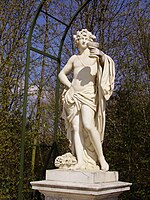Hall of Mirrors
1682 establishments in FranceBaroque architecture at VersaillesBuildings and structures completed in 1682Individual roomsMirrors ... and 1 more
Palace of Versailles

The Hall of Mirrors (French: Grande Galerie, Galerie des Glaces, Galerie de Louis XIV) is a grand Baroque style gallery and one of the most emblematic rooms in the royal Palace of Versailles near Paris, France. The grandiose ensemble of the hall and its adjoining salons was intended to illustrate the power of the absolutist monarch Louis XIV. Located on the first floor (piano nobile) of the palace's central body, it faces west towards the Palace Gardens. The Hall of Mirrors has been the scene of events of great historic significance, including the Proclamation of the German Empire and the signing of the Treaty of Versailles.
Excerpt from the Wikipedia article Hall of Mirrors (License: CC BY-SA 3.0, Authors, Images).Hall of Mirrors
Rue des Récollets, Versailles
Geographical coordinates (GPS) Address Website Nearby Places Show on map
Geographical coordinates (GPS)
| Latitude | Longitude |
|---|---|
| N 48.804833333333 ° | E 2.1203333333333 ° |
Address
Château de Versailles
Rue des Récollets
78000 Versailles, Saint-Louis
Ile-de-France, France
Open on Google Maps










